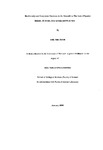Biodiversity and Ecosystem Processes In the Strandline: The Role of Species Identity, Diversity, Interactions and Body Size
| dc.contributor.author | Marsh, Sally Jane | |
| dc.contributor.other | Faculty of Science and Engineering | en_US |
| dc.date.accessioned | 2013-10-09T11:10:23Z | |
| dc.date.available | 2013-10-09T11:10:23Z | |
| dc.date.issued | 2008 | |
| dc.identifier | NOT AVAILABLE | en_US |
| dc.identifier.uri | http://hdl.handle.net/10026.1/2118 | |
| dc.description.abstract |
In the current climate of biodiversity loss how species diversity and ecosystem process are linked is, arguably, one of the most pressing issues and greatest challenges currently facing the scientific community. Previous studies suggest that there is no universal trajectory for the relationship between diversity and ecosystem processes, the pattern depends largely on species identity and their interactions. Furthermore, the effect of reduced diversity on ecosystem process in multi-trophic assemblages is both understudied and poorly understood. Consequently, the overall aim of the present study was to investigate the role of species identity, diversity and interactions in determining ecosystem processes using the strandline as a model system. Appropriate strandline species, three species of kelp fly larvae, an amphipod and four rove beetles were selected for use in laboratory manipulative experiments that measured decomposition as an ecosystem process. This study is one of the few to consider the affect of species interactions on ecosystem processes. The use of metabolic theory to make predictions of trophic interactions and ecosystem processes, using tractable surrogate measures of interaction strength, was also investigated. Finally, the importance of trophic interactions in affecting the connection between ecosystem processes and consumer species identity, diversity and interactions was examined. Species identity combination explained the variability in decomposition when strandline decomposer diversity and identity were manipulated. Positive and negative interactions were identified, and the effect of diversity on decomposition was dependent on the balance of these negative and positive species interactions. A mechanism of microbial facilitation and inhibition was proposed to explain the outcome as no previously proposed single mechanism adequately described the observed effect of species identity, diversity and interactions on ecosystem process found in this study. It was not possible to accurately predict observed predator-prey interaction strengths and ecosystem processes between strandline predators and prey and decomposition using body size as a surrogate measure of interaction strength and ecosystem processes. Although body size was an important factor explaining the variability in predator-prey interactions and decomposition, so too was species identity. The absence of a consistent relationship between size and interaction strength and decomposition was attributed to species-specific differences. The presence of trophic interactions subtly affected decomposition of wrack by strandline detritivores. However, in the presence and absence of a predator the overall effect of detritivore diversity and interactions on decomposition remained constant. The results of this study have implications for the fields of biodiversity ecology, metabolic theory of ecology and food web ecology. Firstly, the identification of positive detritivore-resource interactions adds to a growing body of evidence that some detritivore species may interact positively, with respect to ecosystem processes. The loss of species within a trophic group may result in a greater reduction in ecosystem processes than previously thought. If positive species interactions are prevalent, ecosystem process will decrease to a greater extent as species are lost, than that predicted from single species processing rates. By considering species interactions, future biodiversity ecosystem processing studies may better understand the effects of species diversity and identity on ecosystem process. It is also suggested that patterns and relationships uncovered in previous studies investigating the effects of species from a single trophic level on ecosystem process may still be valid in more realistic multi-trophic systems. If future biodiversity-ecosystem process studies are to make predictions concerning actual species-ecosystem process interactions in real assemblages the size of constituent species should be considered, as predator and prey size was shown to effect predator-prey interactions and ecosystem processes. The results of this study also suggest that allometry and metabolic theory have limited capacity for making predictions of predator-prey interactions and ecosystem processes, at least at the scale investigated here. Species specific factors are more likely to explain the patterns of predator-prey interactions and ecosystem processes at smaller scales. Unless food web models consider, or allocate, non-trophic interactions correctly, erroneous predictions of energy How and ecosystem process may result. Finally, the use of body size and allometric scaling laws to quantify food web models and energy fiow through an assemblage must be treated with caution if these models are used to make predictions on interactions between species and ecosystem processes occurring at the scale investigated in this study. | en_US |
| dc.description.sponsorship | Plymouth Marine Laboratory | en_US |
| dc.language.iso | en | en_US |
| dc.publisher | University of Plymouth | en_US |
| dc.title | Biodiversity and Ecosystem Processes In the Strandline: The Role of Species Identity, Diversity, Interactions and Body Size | en_US |
| dc.type | Thesis | |
| plymouth.version | Full version | en_US |
| dc.identifier.doi | http://dx.doi.org/10.24382/3533 |
Files in this item
This item appears in the following Collection(s)
-
01 Research Theses Main Collection
Research Theses Main


